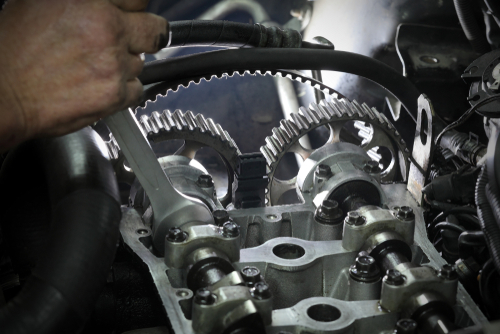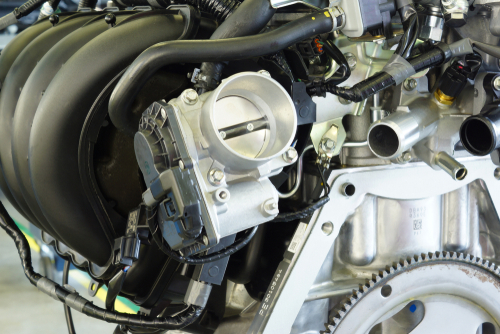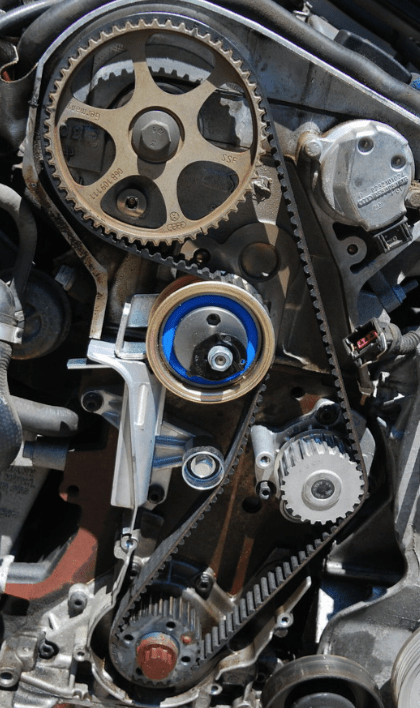Has your check engine light recently illuminated, accompanied by the mysterious P0016 code? Don’t worry, you’re not alone in this automotive conundrum.
This pesky code, which stands for “Crankshaft Position – Camshaft Position Correlation (Bank 1 Sensor A),” is more common than you might think.

The P0016 code indicates that your engine’s crankshaft and camshaft are not playing nice together, potentially throwing off the crucial timing of your engine’s internal dance. This synchronization is vital for your engine to run smoothly, efficiently, and without causing damage to its components.
You might be wondering what could cause this timing mismatch. Well, it could be anything from a stretched timing chain to a faulty sensor.
But don’t fret! With a bit of knowledge and some detective work, you’ll be well on your way to solving this automotive mystery and getting your engine back in sync.
Key Takeaways
- P0016 indicates a timing issue between your engine’s crankshaft and camshaft
- Symptoms may include poor engine performance and decreased fuel efficiency
- Diagnosis often requires professional tools, but fixing can range from simple sensor replacement to more complex repairs
Understanding the Basics
The P0016 code points to a timing issue between your engine’s crankshaft and camshaft. This problem can leave you scratching your head, but don’t worry – we’ll break it down for you.
What Is P0016?
P0016 is an OBD-II diagnostic trouble code that indicates a correlation problem between your crankshaft and camshaft positions. It’s like your engine’s internal dance partners are out of sync!
This code specifically relates to Bank 1 Sensor A, which is typically on the side of the engine with cylinder #1. When your car’s computer detects this mismatch, it’s telling you, “Hey buddy, something’s not right with the timing!”
Common culprits include a stretched timing chain, worn timing belt, or issues with the camshaft position (CMP) or crankshaft position (CKP) sensors. It’s like your engine’s choreography has gone awry, and these parts are the lead dancers.
Working of Crankshaft and Camshaft Sensors
Your engine’s crankshaft and camshaft sensors are like the eagle-eyed judges of this mechanical dance-off. They constantly monitor the positions of these crucial components.
The crankshaft position sensor keeps tabs on the engine’s rotational speed and position. Meanwhile, the camshaft position sensor tracks the camshaft’s position. Together, they ensure your engine’s valves open and close at just the right moments.
These sensors feed data to your car’s computer, which uses this info to control fuel injection and ignition timing.
When the P0016 code pops up, it’s like the judges have spotted a dancer out of step. Your car’s computer is saying, “Hold up! The crankshaft and camshaft aren’t moving together as they should.”
Remember, proper timing is crucial for your engine’s performance. Without it, you might experience rough idling, poor acceleration, or even engine stalling. It’s like trying to dance the tango while your partner’s doing the cha-cha!
Symptoms and Causes

When your engine throws a P0016 code, it’s like your car is telling you it’s got timing issues. Let’s look at what might be going wrong and why your trusty ride is acting up.
Common Symptoms of P0016
Your car might start acting like a teenager who doesn’t want to get out of bed. You’ll notice rough idling, as if your engine is grumbling about its day. Sometimes, it might even stall on you, leaving you stranded like a bad date.
Keep an ear out for that engine misfire – it’s like your car’s way of coughing and sputtering. You might feel a loss of power, as if your car suddenly decided it’s too lazy to climb hills. And don’t be surprised if your fuel economy takes a nosedive. It’s like your car developed a drinking problem overnight!
What Causes P0016 Error?
Now, let’s talk about why your car is throwing this tantrum. The most common culprit? A worn timing belt or chain. It’s like the belt holding up your car’s pants has gotten too loose.
Your camshaft phaser might be out of whack, kind of like when your watch is a few minutes off. Sometimes, it’s just bad sensors or wiring playing tricks on your car’s computer.
Don’t forget about oil! Low oil or poor oil quality can mess with your engine’s timing. It’s like trying to run a marathon without proper hydration. And in rare cases, it could be internal engine damage. That’s the automotive equivalent of finding out you need surgery – not fun, but sometimes necessary.
Diagnosis and Diagnostics

Tracking down that pesky P0016 code can be like finding a needle in a haystack. But don’t worry, we’ve got some tricks up our sleeves to make your life easier. Let’s dive into the nitty-gritty of diagnosing this tricky timing issue.
Troubleshooting Steps
First things first, pop the hood and give your engine a good once-over. Look for any obvious signs of trouble, like a loose timing belt or chain.
If everything looks ship-shape, it’s time to get your hands dirty.
Check your engine oil level and quality. Low or dirty oil can wreak havoc on your camshaft phaser. While you’re at it, inspect the wiring connections to your crankshaft and camshaft sensors. Loose or corroded wires can cause all sorts of mischief.
Next, take a peek at your timing marks. If they’re not lining up like ducks in a row, you might have a timing chain or belt issue. Don’t forget to check those timing chain guides and tensioners too!
Using Diagnostic Tools
Now it’s time to break out the big guns – your trusty OBD-II scanner. This little gadget is worth its weight in gold when it comes to decoding that P0016 mystery.
Plug in your scanner and check for any additional codes that might be tagging along with P0016. These can give you valuable clues about what’s going on under the hood.
If you’re feeling fancy, a more advanced scan tool can give you real-time data from your crankshaft and camshaft sensors. This can help you spot any timing discrepancies that might be causing your P0016 headache.
Don’t have a fancy scanner? No worries! You can still use a multimeter to check the resistance and voltage of your sensors and wiring. Just remember to consult your vehicle’s service manual for the correct specs.
Technical Deep Dive
Let’s pop the hood and take a closer look at what’s really going on with this pesky P0016 code. You’ll be amazed at how these engine components dance together in perfect harmony – when they’re working right, that is.
Camshaft-Crankshaft Correlation
Picture this: your engine’s crankshaft and camshaft are like dance partners at a mechanical ball. They need to move in perfect sync for your engine to run smoothly.
The crankshaft position sensor and camshaft position sensor are like eagle-eyed dance judges, making sure these two are always in step.
When these sensors detect that the dance routine is off, they throw a fit – aka the P0016 code. It’s their way of saying, “Hey, something’s not right here!” This mismatch can happen due to a stretched timing chain, worn-out gears, or even a faulty sensor.
Timing System Mechanism
Now, let’s talk about the backstage crew that keeps this dance show running. Your engine’s timing system is like a well-oiled machine… literally!
The star of the show is the timing chain or belt, connecting the crankshaft and camshaft.
These components work together to ensure your valves open and close at just the right moment.
It’s a precision job, folks! If your timing chain stretches or loses a tooth, it’s like your dance partners trying to waltz to different tunes.
And let’s not forget about those tone rings. These little guys are like the metronome for your engine, helping the sensors keep track of position and speed. If they get damaged or misaligned, it’s like trying to dance with two left feet!
Fixing the Issue
Got a P0016 code lighting up your dash? Don’t worry, we’ve got you covered. Let’s dive into how to get your engine purring again without breaking the bank.
Repair Solutions
First things first, you’ll want to check that Variable Valve Timing (VVT) system. It’s like the conductor of your engine’s orchestra, and when it’s off-beat, things go haywire.
Start by inspecting the VVT solenoid. It might be clogged or faulty, and cleaning or replacing it could solve your problem.
Next up, take a gander at your timing belt or chain. If it’s looser than your uncle’s dentures, it might need tightening or replacing. Don’t forget to check that tensioner too!
Lastly, give those crankshaft and camshaft sensors a once-over. They’re the tattletales of your engine, and if they’re fibbing, you’ll need to set them straight.
Cost Estimates
Now, let’s talk turkey. Fixing a P0016 code can range from “piece of cake” to “ouch, my wallet!”
• VVT solenoid replacement: $100-$300 • Timing belt/chain replacement: $500-$1000 • Sensor replacement: $200-$400 • PCM replacement (worst case): $500-$1000
Keep in mind, labor costs can vary wildly depending on your ride and your mechanic. If you’re handy with a wrench, you might save a pretty penny doing some of these repairs yourself.
Frequently Asked Questions
P0016 codes can be tricky to diagnose and fix.
Let’s tackle some common questions about this pesky engine issue that might leave you scratching your head.
How do I locate and fix a P0016 code in my vehicle?
First, you’ll need to scan your vehicle’s computer with an OBD-II reader.
Once you’ve confirmed the P0016 code, check your oil level and quality. Low or dirty oil can cause timing issues.
Next, inspect your timing chain or belt for wear. If those look good, you might need to replace the camshaft or crankshaft position sensors.
What does the code P0016 mean for my car’s performance?
When your car throws a P0016 code, it’s saying your crankshaft and camshaft aren’t playing nice together.
This can lead to poor engine performance, reduced fuel economy, and in some cases, your car might not even start.
You might notice rough idling, stalling, or a lack of power when accelerating.
It’s like your engine is trying to waltz while your transmission is doing the cha-cha.
Is it possible to drive my car if I’m getting a P0016 error, or should I tow it to a mechanic?
While you might be able to limp your car to the nearest shop, it’s not recommended.
P0016 is considered an important trouble code that shouldn’t be ignored.
Continuing to drive could cause further damage to your engine. It’s best to play it safe and have your vehicle towed to a mechanic. Your wallet will thank you later.
Can you explain the difference between Bank 1 Sensor A and Bank 1 Sensor B in layman’s terms?
Think of Bank 1 and Bank 2 as the left and right sides of your engine. Bank 1 is typically the side with cylinder #1.
Sensor A usually refers to the camshaft position sensor, while Sensor B is often a secondary sensor.
In a P0016 code, we’re dealing with Bank 1 Sensor A, which is keeping tabs on your camshaft’s position relative to the crankshaft.
Where exactly can I find the camshaft position sensor for Bank 1 Sensor A in my Toyota?
The location of the camshaft position sensor can vary depending on your specific Toyota model.
Generally, you’ll find it near the top of the engine, often close to the valve cover.
It might be on the front, back, or side of the cylinder head. Check your vehicle’s manual or a reliable online resource for the exact location in your Toyota.
Could you tell me which camshaft sensor is labeled as Bank 1 Sensor A in my engine?
Bank 1 Sensor A typically refers to the camshaft position sensor on the same side of the engine as cylinder #1.
In most engines, this is the front of the engine on the passenger side.
However, the exact labeling can vary between manufacturers.
When in doubt, consult your vehicle’s service manual or a reputable online automotive forum for your specific make and model.
